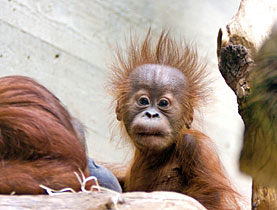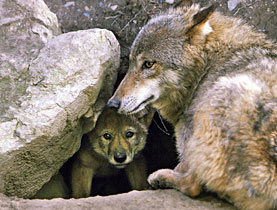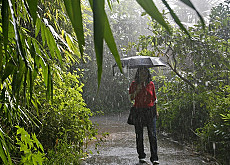Birds do it, bees do it…

Love, they say, makes the world go round. But at Zurich Zoo it's essential to ensure the success of its breeding programmes for endangered species.
Documentary maker Marianne Pletscher spent two and a half years at the zoo observing its efforts to encourage orang-utans and snow leopards to produce babies.
Love, death – and, of course, sex – all feature in the film, which also has a serious message about animal conservation.
One of the stars of the two-part documentary, which is being shown on Swiss television, is Djarius, a young male Sumatran orang-utan from Germany, who was sent to Zurich after the old orang-utan patriarch died.
But it took almost one and a half years before a baby was born to one of the seven females.
“When he met his wives one by one it went very quickly, we didn’t really understand what was happening they were just jumping around with each other,” recalls Pletscher.
Aping around
“I guessed they were already doing what they were supposed to be doing, but it was so fast and so much hair you couldn’t tell!”
Djarius was still young and after the death of the old male, the females had simply got used to life without a man, with a senior female leading the group.
“When he was together with all of them he was very shy because there were still some levels and rules about how they behaved with each other, and he wasn’t tall and strong enough to be the new ruler,” Pletscher told swissinfo at a screening of the film at Zurich Zoo.
“So it took him time, but when the baby came – Hadiah, a very nice little ape – everyone was happy and now Djarius behaves like the boss.”
Free Villy
Even more shy was Villy, the male snow leopard sent from Tallinn in Estonia to be a mate for the widowed Dshamilja. His journey showed just how much time, effort and red tape is needed for an animal to cross Europe. It was also a stressful experience for the wildcat.
“We really lived with him how difficult it is to leave one place and arrive in another,” explained the documentary maker.
“It took him nearly a year to be able to go out of the cage because he did not have such a nice place to live where he comes from and the freedom made him afraid.”
Villy is now also a father. But some relationships do not turn out as well – a male tiger ended up killing a potential mate.
A question of breeding
Animals are brought in from other zoos around the world to ensure genetic diversity. Ideally there should be up to 95 per cent variability through the parent animals maintained for 100 to 200 years, according to zoo curator Robert Zingg.
The breeding programmes, coordinated by the member institutions of the European Association of Zoos and Aquaria, match up good potential candidates.
For example, Dshamilja, the female snow leopard, was caught in Tajikistan after becoming caught in a hunter’s trap. The animal, now lame in one foot, would not have survived in the wild, but in the zoo her “fresh” genes are extremely valuable. Her mate, Villy, was born in Tallinn Zoo.
Zurich Zoo takes part in around 50 species breeding programmes, of which it is in charge of four. It is the only European institution to breed the Galapagos giant tortoise with success.
Man as the enemy
An estimated one quarter of the world’s animals are endangered, with orang-utans and snow leopards among the most vulnerable. There are only around 9,000 of the apes left in the world and much of their native habitat is being destroyed.
Hunters have decimated snow leopard numbers, with no more than 7,500 of the animals remaining in the wild.
So behind the humorous moments in the documentary, there is also a serious message, says zoo director Alex Rübel.
“The final goal is actually to conserve these species in the wild and from that point of view the most important role of zoos is a communication role, to show people why these animals are in danger and how we can help save these species in the world,” Rübel told swissinfo.
Reserve population
“I see the zoo as an ambassador and as a peer agency for animals in the wild, while still trying to use our animals here as a reserve population in case we need to reintroduce them.”
For some species, says Rübel, there are only 50 to 60 animals left in the wild.
For Rübel and Pletscher, the sight of the cute baby orang-utan and the seemingly cuddly baby snow leopard in the film should help bring home the importance of preserving endangered species.
The new additions also go to show that in the global world of zoo breeding programmes, love really does make the world go round.
swissinfo, Isobel Leybold-Johnson at Zurich Zoo
The two 50-minute documentaries are being shown on Swiss television and later on 3sat. They will also be issued on DVD. Other animals featured are rhinos, tigers, lions and Galapagos tortoises.
Marianne Pletscher studied documentary making in Zurich and the United States. She has won several awards for her films and also teaches the subject.
The idea for her latest project came after she filmed at the zoo in 2004 and realized how global modern zoos are. The project was originally meant only to follow Djarius, but as he took so long to “do his duty”, Pletscher was able to film other stories as well.
Orang-utan
Also known as the red ape, or the “old man of the forest”, orang-utans are the largest tree-living mammals. They can live for up to 60 years.
Orang-utans are endangered due to deforestation of their habitat and through land conversion to palm oil plantations. Sumatran orang-utans are disappearing at a rate of 1,000 a year and there are only around an estimated 9,000 Sumatran orang-utans left in the world.
Snow leopards
Snow leopards live in Central Asia and can live up to 21 years. They are solitary animals that mainly hunt at dawn and dusk.
The bones and fur of the leopard are a lucrative business for poachers and they are also unloved by farmers. There are estimated to be only 4,500 to 7,500 snow leopards remaining in the wild.

In compliance with the JTI standards
More: SWI swissinfo.ch certified by the Journalism Trust Initiative



You can find an overview of ongoing debates with our journalists here . Please join us!
If you want to start a conversation about a topic raised in this article or want to report factual errors, email us at english@swissinfo.ch.